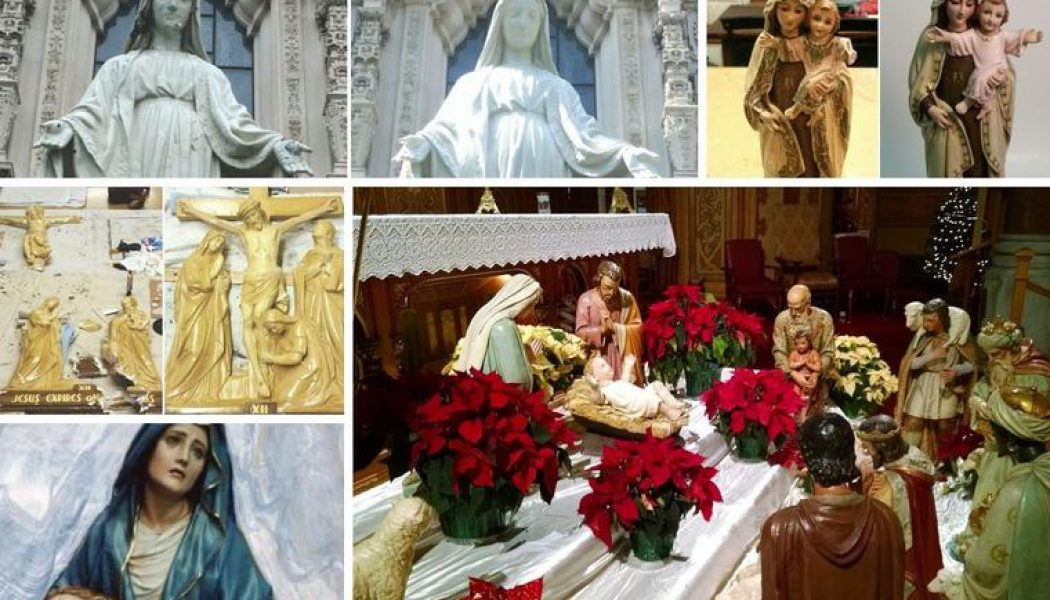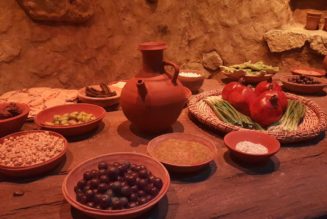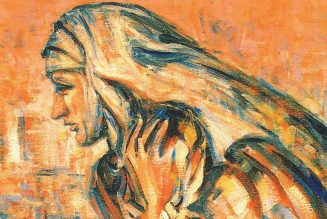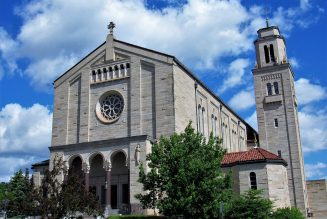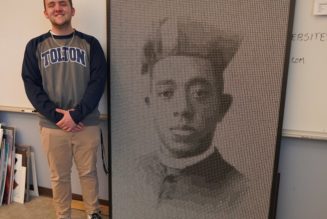
St. Michael’s Catholic Church stands like its namesake sentinel over a city that needs the church’s presence. For the faithful who cross the threshold, the doors of this neo-Gothic church open wide to reveal a pageant of color and light.
Around the Rochester, New York, sanctuary and upon the altar are the statues, which, despite the passage of decades, have been renewed in splendor by a local artist and longtime parishioner.
“I’ve been doing this for 18 years and really got into it by accident,” Arlene Miller told the Register. A number of beautiful statues were sold by another city parish, and rather than let them be carted off, a group from St. Michael’s bought them to adorn their cathedral-like parish, and Miller was asked to restore their beauty and help add richness to the people living in one of the poorest parts of the city.
“I then did them all at St. Michael’s,” she said of the restoration initiative.
Miller is one artist whose vocation encompasses repainting and renewing Catholic devotional statues in an era where broken things — and, too often, broken people like those in Rochester — end up being thrown away.
Miller credits her mother with starting her lifelong love of painting by giving her a box of paints she had scrimped to purchase and pointing her to some leftover fabrics stored in the attic.
The crown jewel of Miller’s work, she told the Register, is the Rochester church’s Christmas Nativity scene. She patiently cleaned, restored with clay and then painted with colors each figurine to capture the light for Christmas night. The restoration fixed the saddle on the Wise Man’s camel, healed the broken limbs of the lambs, and made the Three Kings look regal. At St. Michael’s Christmas midnight Mass, these statues are front and center before the altar.
“They all became my friends,” Miller said. “Once someone came in and asked me, ‘Are you talking to them?’” Now, people bring her their statues to bring back to life, from a broken statue of St. Michael and an Infant of Prague statue missing the cross from the world in his hand to a depiction of the Blessed Mother with her hands missing. All these statues have special meaning to people, but Miller said that, above all, they draw a person back to the presence of God.
“They keep you aware and remind you ‘Ah, yes, God — I must pray to him today,’” she said.
At a time when Catholic statues have been in the news for being vandalized, skilled restorationists of Catholic statues are bringing them back from the brink, or even bringing out the latent beauty that skilled human hands placed in the statue — the kind of beauty that cannot be replaced by modern mass-manufactured statuary.
Similar to Miller, Sheila Lehman, an interior decorative painter in Arcadia, California, fell into the business of restoring statues as a favor to her parish church. She was asked to repair a badly damaged wooden statue and started applying tremendous technical skill and knowledge of paint and color to the repair. Reflecting on seeing the finished piece back in its place in the sanctuary, Lehman had a profound realization as she walked home.
“I could do this forever,” she thought to herself.
Lehman reached out to parish churches in Southern California and found herself with a steady business, which she named “Paint Changes Everything.” The new business expanded by word of mouth. As a testimony to her skill and the beauty of the final product, Lehman provides her clients “before-after” photos of the statues she has restored. “Those pictures are like my résumé,” she said. One of the pictures she shows prospective customers — usually pastors and parish staff — is a 12th Station of the Cross that crashed to the floor when the wire affixing it to the church wall broke.
The original 1920s design of the artwork had flaws she needed to overcome in the restoration by adding a combination of support beams, wood and epoxy. “That probably still today is the most difficult piece I’ve done,” she said.
Lehman said one beautiful thing about restoration work is that she’s surrounded by these beautiful statues as she works in her studio.
Some projects happen outside the studio: such as an Our Lady of Grace statue, done in a Spanish Baroque style, that had been vandalized in 2019 with excrement, for reasons unknown, whether it was malice, mental affliction, or both.
But regardless of the project, people love when they see the statue renewed in beauty. “People go crazy when they see it back,” she said. “And you’re deeply happy to make something beautiful again.”
As a little girl in western Pennsylvania, artist Mary Birkos would sit in the pew of the Catholic church and bask in the beauty of light and color found in the sanctuary.
“I was poor, and I used to sit in church and look at all the beautiful artwork,” Birkos said. She felt drawn to paint, but her family could not afford it. But she would ask the religious sisters at the Catholic school if they needed help, and in return, they gave her paints, brushes and supplies so precious to her.
Birkos eventually would make her life’s work painting high on scaffolds, adorning churches all over Pennsylvania for 50 years. The church that inspired her vocation was torn down for a modern building that lacked the beauty of the original — an event that was painful for Birkos. Now in her late 60s, her scaffolding days are over, but the statue restoration continues.
“I was always doing something I loved,” she said, although as beautiful as the work is, it pays very little for the artist. “To me, the proper way to do a statue is the same way you’d do a painting,” she said.
The personal encounter with Beauty in this work is a spiritual experience unto itself, she said.
“It does affect you,” she said, remarking on the oneness of the work through the process to stepping back and seeing it finished and resplendent. “It makes you cry.”
Join Our Telegram Group : Salvation & Prosperity
